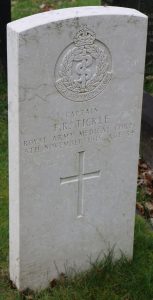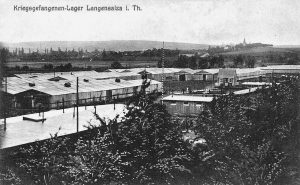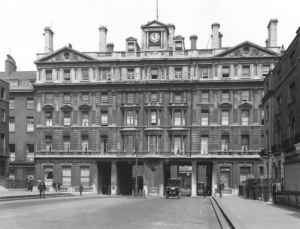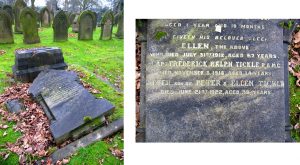 Military unit: Royal Army Medical Corps, attached to 7th Battalion, Rifle Brigade
Military unit: Royal Army Medical Corps, attached to 7th Battalion, Rifle Brigade
Date & place of birth: 17 August 1884 at St. Helens, Lancashire
Date & place of death: 4/5 November 1918 (aged 34) at Euston Station Hotel, London
Frederick Tickle was a doctor with the RAMC. He spent the last six months of the war as a Prisoner of War, but committed suicide shortly after his repatriation.
Family background
Frederick Ralph Tickle was born on 17 August 1884 at the Cuerdley Arms public house in Church Street, St Helens, Lancashire. He was the sixth child of Peter Tickle (1843–1902) and his second wife, Ellen née Thompson (1851–1912).
Peter Tickle was born at St Helens on 21 February 1843, the son of a builder. By the time he was 18, he was following his father into the building trade and was employed as a joiner. On 31 January 1865, he married Elizabeth Radcliffe; their first child, Margaret was born on 7 November 1865, but Elizabeth died the following February, leaving Peter as a 22-year old widower, with a 4-momth old baby daughter.
It wasn’t until 27 February 1877 that Peter, still a joiner by trade, re-married, aged 34, to 25-year old Ellen Thompson. Ellen, also from St Helens, was the daughter of a plate glass finisher. The couple’s first child, Thomas Rainford Tickle, was born on 28 December 1877, followed by two daughters, Ann and Louisa. Sadly, Louisa died shortly before her second birthday. Three more sons followed at roughly one year intervals, including Frederick, before a daughter born in 1886 and the eighth child, Matthew born in May 1890, when Ellen was 39.
Frederick was baptised on 7 September 1884 at St Peter’s Church in Parr, St Helens, close to his mother’s family home.
Peter is first recorded as a hotel manager in October 1879, when he was a witness in a trial at Liverpool Assizes in which John Jones was charged with “uttering base coins”. In the 1881 census, Peter and Ellen, together with Margaret and their three children were living at the Cuerdley Arms in Church Street, St Helens.
By the 1891 census, Margaret had married and left home, but Peter and Ellen and their seven children, including 6-year old Frederick, were now living at 23 Sutton Road, St Helens where Peter was a self-employed building contractor.
Ten years later, the family were at 3 Cowley Hill Lane, St Helens. 16-year old Frederick was now recorded as a “medical student”.
Peter died on 17 May 1902, aged 59, leaving an estate valued at £10,795.
On 17 October 1908, at the St Helens Wesleyan Chapel in Corporation Street, Frederick married Lilian (Lily) Moulds (1884–1971). Her father, William Arthur Moulds (1859–1930) was a master tailor. At this time, Frederick’s address was given a Thorndale, Winchester Road, Southampton.
At the 1911 census, Frederick and Lily were living at 148 Portswood Road, Southampton, with a live-in servant, 27-year old Ada Kells, from St Helens. The couple had three daughters, all born in Southampton:
Mary Patricia, born 9 June 1911
Margaret (Peggy), born 27 April 1914
Joan, born 10 April 1917
Education and medical career
Frederick was educated at The Cowley School, St Helens before being admitted as a student at Liverpool University College in October 1901, from where he graduated with first-class honours as M.B., Ch.B. (Bachelor of Medicine, Bachelor of Surgery) in 1908.
After acting as house physician at Liverpool Infirmary for a short time, he went into practice in Southampton. In November 1908, he appeared as a witness at a coroner’s inquest into the death of a one-day old baby.
He became the medical officer of No. 5 District and public vaccinator of No 4 District of the Southampton Union, and also commandant of the Southampton Women’s Voluntary Aid Detachment.
In the 1911 Kelly’s Directory, Frederick is listed as being in partnership with 27-year old Edmund Alderson, a fellow graduate from Liverpool University, with surgeries at 303 Portswood Road and in Shirley Road, Southampton. The partnership was formally dissolved on 5 November 1912.
Masonic career
On 14 January 1908, Frederick Tickle was initiated into the St Helens Lodge of Loyalty, No 897, where his future father-in-law; William Moulds, was a member, having been initiated in May 1894.
Frederick was passed to the second degree on 11 February and raised to the degree of Master Mason on 10 March (within two months of his initiation). In the Lodge records, his address was given as 23 Westleigh, Dentons Green Lane, St Helens.
Frederick resigned from the lodge in October 1910. He was then unattached for over two years, until he joined Shirley Lodge No 1112 in Southampton on 3 February 1913.
Military service
In October 1916, the Hampshire Telegraph reported on a meeting of the Southampton Guardians (in charge of the workhouse in St Mary Street). The clerk reported to the committee that he had been informed by Dr. F.R. Tickle, a district medical officer, that “there was every possibility of him being called upon to take a commission in the RAMC. It was resolved that every possible step be taken to retain the service of Dr Tickle; also that the Central Medical Committee and the Local Government Board be urged to allow Dr. Tickle to remain at his civil employment.”
Despite the committee’s request, Frederick was called up and, on 22 January 1917, he was commissioned as a temporary Lieutenant in the Royal Army Medical Corps. He was soon sent to France and attached to the 7th Battalion, Rifle Brigade (part of the 14th Division, 41st Infantry Brigade), being promoted to Captain on 22 January 1918.
As the Battalion Medical Officer, he had an arduous task, combining the roles of G.P., casualty officer in battle, and public health officer responsible for the general health of his unit. In action, his role was to sort casualties between those who had no chance, those who required early life saving intervention before they could be evacuated to a Casualty Clearing Station, and those who needed less urgent treatment.
The first major action in which he was involved was at the Battle of Arras in April 1917, in which the battalion suffered the deaths of one officer and nine men, with two officers and 80 men wounded in four days of heavy fighting at the start of the battle.
Over the next year, the battalion were rarely far from the front line and were regularly engaged in heavy fighting. At Wancourt in mid-May, they suffered 21 men killed, with 32 injured (of whom 5 subsequently died from their wounds) and 9 admitted to hospital with shell-shock.
By late August, the battalion had moved into Flanders and were engaged in the Battle of Passchendaele (Third Battle of Ypres) in which the 41st Brigade suffered horrendous casualties in dreadful weather, with the battalion losing over 130 men killed or wounded.
Over the next six months, the 7th Battalion continued to incur heavy casualties and by mid-March 1918 they were in the vicinity of Essigny, south of St Quentin in northern France, where they were engaged on routine work on the defences.
On 21 March 1918, the German army launched their Spring Offensive, codenamed “Operation Michael”. At 4 a.m. the enemy opened a heavy bombardment including gas shells, during which the battalion very quickly lost contact with HQ. The war diary reports:
Owing to the fact that no one who was present in the Battle Zone with the battalion succeeded in establishing touch with the transport, it is impossible to attempt to give a lucid account of what happened in the Forward Zone.
By the end of the day, 20 officers and 525 men were missing (of whom 47 were subsequently confirmed as dead). The remnants of the battalion (4 officers and 100 other ranks) withdrew from the front line. On 27 April, the battalion was reduced to cadre strength.
Prisoner of War

Frederick Tickle was taken into captivity as a prisoner of war and initially sent 480km to Rastatt camp, near Karlsruhe in Germany, before being sent on to the Prisoner of War camp at Bad Langensalza, 400km north-east.
One inmate at Langensalza camp, Captain C.N. Barlow of the King’s Royal Rifle Corps, described the conditions:
The food in the hospital was sufficient and the accommodation was not so bad, but the sanitary arrangements were perfectly appalling. The latrines, long troughs with seats over them, were used by prisoners of all nationalities and no attempt was made to clean them; the smell was terrible and the walls were smeared with filth.
On his arrival at Langensalza, Frederick was put in charge of a ward. He was one of six officers in the camp at that time. Captain Barlow’s report continues:
The British doctors were very much disgusted with the conditions at Langensalza. They seemed to be determined there should be an improvement, and up to the time that I left, they appeared to be on good terms with Dr Keppel [the German surgeon at the camp].
They were allowed to go out in the town of Langensalza, and they were quite satisfied with the manner in which they were treated during the time I was with them.
In late October, Frederick was repatriated to England, via Boston in Lincolnshire. He reached London early on 2 November, and arrived at the Prince of Wales Hospital for Officers (formerly, the Great Central Hotel), near Marylebone Station at 2 a.m. At 8 o’clock that morning he was seen by the adjutant of the hospital, Captain A.W. Matthews, R.A.M.C., who gave Frederick 48 hours leave, expecting him to go home to see his wife in Southampton.
Instead, Frederick remained in London and later that day checked in to the St. James Palace Hotel. The next morning, Lily Bird, a chambermaid, passed the door to his room. She saw him sitting on a chair looking ill and drowsy and recommended that he return to bed. She later brought him some tea. The following morning, Frederick told Lily that he was feeling better and that he would leave the hotel after breakfast.
During the next two days, Frederick attempted to purchase a revolver from a shop in the Strand, but was unsuccessful as he didn’t have the necessary licence from the War Office.
Having failed in his attempt to purchase a weapon, he visited a pharmacist where he bought a hypodermic syringe together with a supply of aconite and some other drugs, including morphine, telling the pharmacist that he needed the drugs to prepare cough mixture to take back to France for the men in his battalion.
Later that evening, he checked in to the Euston Station Hotel, under the name “Frederick Gray”.
Death, inquest and commemoration

In the morning of Tuesday 5 November 1918, Frederick was found dead in a bedroom at the Euston Station Hotel. He was found lying on the bed partly dressed, with a hypodermic syringe and some tubes contain drugs near his body.
An inquest was held by the St Pancras Coroner, Walter Schroeder on 8 November. At the inquest, the body was identified by Frederick’s elder brother, William, a draughtsman employed by the War Office.
Frederick’s widow, Lily, then gave evidence, struggling not to break down in tears. She said that she had last seen Frederick in March, when he came home on leave from France. During the time that he had been a prisoner of war in Germany, he wrote to her every month. She had last heard from him about a fortnight ago. She did not know that he was in England until she received an incoherent letter from him with a London postmark on the Monday before he was discovered.
The coroner then adjourned the inquest until 6 December. In the meantime, a funeral was held on Monday, 11 November (the day that the Armistice was signed) at St Helens Cemetery, where he was interred in the family grave with military honours.

The reconvened inquest was held in front of a jury, necessitating the reading through of the evidence given at the earlier hearing – this caused Lily further distress.
In his evidence to the inquest, John Webster, F.I.C., an analytical chemist at the Home Office, said that he had analysed the stomach, liver and kidneys of the deceased, in which he found approximately one-tenth of a grain of alkaloid of aconite (one-twentieth to one-thirtieth of a grain would be sufficient to cause death). He also found slight traces of morphine. Three cases of hypodermic tabloids, all of which were poisonous, were empty. He had examined the syringe, and found traces of the poisons on it. He “could not say how long death had supervened after the entry of the poisons into the body, but possibly only a short time”.
Dr. Bernard H. Spilsbury, the eminent pathologist from St. Mary’s Hospital (who was a pathologist at the trial of Dr. Hawley Crippen, and whose evidence helped convict Crippen of the murder of his wife), gave evidence that he had found eleven puncture wounds on Frederick’s left arm. Taking into account the evidence from Mr. Webster, his opinion was that death “was due to coma following the taking of aconite”. “The deceased had more than probably became unconscious shortly after the taking of the drug, and death was possibly quite peaceful.”
The next witness, Lieut. David Robertson, R.A.M.C., had been at Langensalza camp for the last 4½ months. He advised the inquest that during that time Frederick appeared to be nervous and strained, and suffering from “incipient insanity”, and incapable of carrying out the medical duties assigned to him. At Frederick’s request, he did not make any report about his state of health.
A second fellow prisoner, Lieut. Halbert Green, R.A.M.C., from Portsmouth, said that Frederick was “distinctly neurotic” at Langensalza. He had discussed Frederick’s condition with other medical prisoners in the camp, but they did not consider it sufficiently serious to notify the authorities.
In his summing-up to the jury, the Coroner, said that Frederick had addressed his final letter to his wife “couched in the most affectionate terms”, and written evidently by a man suffering from great mental strain. He did not propose to read that letter to the jury, but only a portion of it. In this Frederick wrote: “Good-bye, we will soon meet again. Kiss all the loved ones for me.”
The jury found that the deceased had died from taking drugs, self-administered, but that at the time he was of unsound mind.
Frederick is commemorated on the Southampton Cenotaph in Watts (West) Park.
In his will, Frederick left an estate valued at £4,298, with Lily appointed as executrix.
Subsequent family history
In 1921, Frederick’s widow, Lily, re-married to Herbert Arthur Reginald Denton (1890–1960), a master-mariner, originally from Kimbolton, Huntingdonshire. Denton was also a Freemason, having been initiated into Euston Lodge No. 2283 at St Neots, Cambridgeshire in November 1915.
Sources
Ancestry.co.uk
1891 England Census
1901 England Census
1911 England Census
Army Registers of Soldiers’ Effects, 1901-1929
British Officer Prisoners of War, 1914-1918
City and County Directories, 1766 – 1946
Medical and Dental Students Registers, 1882-1937
National Probate Calendar (Index of Wills and Administrations), 1858-1966
United Grand Lodge of England Freemason Membership Records, 1751–1921
WWI War Diaries (France, Belgium and Germany), 1914-1920
Bitterne Local History Society: List of Names on the Cenotaph
Bolton Evening News: 15 August 1903. Deeds of Apprenticeship
British Medical Journal: 16 November 1918. Casualties in the Medical Services. Died of Wounds
Cowley Schools: Roll of Honour 1914-1919
CWGC: Casualty details: Captain Tickle, F.R.
Daily Mirror: 7 December 1918. Officer’s Suicide. Tragedy in London Hotel
Find a Grave: Capt. Frederick Ralph Tickle
Great War Forum:
Captain Frederick Ralph Tickle
Hampshire Telegraph:
5 August 1910. Red Cross Work
17 July 1915. Unsound Mind
21 October 1916. The Southampton Guardians
9 November 1918. Death of a Southampton Doctor. Inquest in London
16 November 1918. Funeral of Dr. Tickle
7 December 1918. London Hotel Tragedy. Resumed Inquest on Captain Tickle
International Committee of the Red Cross: Prisoner of War Records: Tickle
London Gazette:
6 February 1917 Supplement: 29934 Page: 1363
1 February 1918 Supplement: 30508 Page: 1627
Masonic Roll of Honour: Captain Frederick Ralph Tickle
The National Archives:
WO 161/96/105: Barlow, C N Page no: 1033-1034 (People mentioned: Captain Tickle)
WO 95/1896/1: 7th Battalion Rifle Brigade (War diary)
Northern Daily Mail: 9 November 1918. Mystery of Repatriated Doctor
St Helens Roll of Honour: Captain Frederick Ralph Tickle
Southern Echo: 25 November 1908. A Brief Existence
Photograph credits
CWGC Gravestone: Find a Grave
Langensalza Camp: hopitauxmilitairesguerre1418
Euston Station Hotel: pinterest.co.uk
Family gravestone: findagrave.com